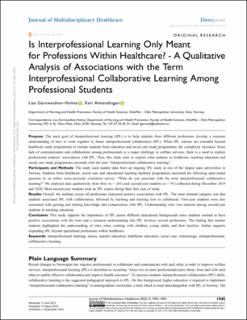| dc.contributor.author | Gardweidner Holme, Lisa | |
| dc.contributor.author | Almendingen, Kari | |
| dc.coverage.spatial | Norway | en_US |
| dc.date.accessioned | 2022-10-03T12:31:22Z | |
| dc.date.available | 2022-10-03T12:31:22Z | |
| dc.date.created | 2022-09-15T10:17:01Z | |
| dc.date.issued | 2022-09-02 | |
| dc.identifier.issn | 1178-2390 | |
| dc.identifier.uri | https://hdl.handle.net/11250/3023372 | |
| dc.description.abstract | Purpose: The main goal of interprofessional learning (IPL) is to help students from different professions develop a common understanding of how to work together in future interprofessional collaboration (IPC). When IPL courses are extended beyond healthcare study programmes to include students from education and social care study programmes, the complexity increases. Since lack of communication and collaboration among professionals is a major challenge in welfare services, there is a need to explore professional students’ associations with IPL. Thus, this study aims to explore what students in healthcare, teaching education and social care study programmes associate with the term “interprofessional collaborative learning”.
Participants and Methods: The study used student data from an ongoing IPL study at one of the largest state universities in Norway. Students from healthcare, social care and educational teaching bachelor programmes answered the following open-ended question in an online cross-sectional evaluation survey: “What do you associate with the term interprofessional collaborative learning?” We analysed data qualitatively from first- (n = 261) and second-year students (n = 97) collected during December 2019 and 2020. Most second-year students took an IPL course during their first year of study.
Results: Overall, the students across all professions expressed positive associations with IPL. The most eminent category was that students associated IPL with collaboration, followed by learning and learning how to collaborate. First-year students were also associated with gaining and sharing knowledge and competencies with IPL. Understanding roles was eminent among second-year students in teaching education.
Conclusion: This study supports the importance of IPL across different educational backgrounds since students seemed to have positive associations with the term and a common understanding that IPL involves several professions. The finding that teacher students highlighted the understanding of roles when working with children, young adults and their families, further supports expanding IPL beyond specialised professions within healthcare. | en_US |
| dc.language.iso | eng | en_US |
| dc.publisher | Dove Medical Press | en_US |
| dc.relation.ispartofseries | Journal of Multidisciplinary Healthcare;Volume 15 | |
| dc.rights | Navngivelse-Ikkekommersiell 4.0 Internasjonal | * |
| dc.rights.uri | http://creativecommons.org/licenses/by-nc/4.0/deed.no | * |
| dc.subject | Interprofessional learning | en_US |
| dc.subject | Nurses | en_US |
| dc.subject | Teacher education | en_US |
| dc.subject | Healthcare education | en_US |
| dc.subject | Social care | en_US |
| dc.subject | Terminology | en_US |
| dc.subject | Collaborative learning | en_US |
| dc.title | Is Interprofessional Learning Only Meant for Professions Within Healthcare? - A Qualitative Analysis of Associations with the Term Interprofessional Collaborative Learning Among Professional Students | en_US |
| dc.type | Peer reviewed | en_US |
| dc.type | Journal article | en_US |
| dc.description.version | publishedVersion | en_US |
| dc.rights.holder | © 2022 Garnweidner-Holme and Almendingen | en_US |
| cristin.ispublished | true | |
| cristin.fulltext | original | |
| cristin.qualitycode | 1 | |
| dc.identifier.doi | https://doi.org/10.2147/JMDH.S376074 | |
| dc.identifier.cristin | 2051906 | |
| dc.source.journal | Journal of Multidisciplinary Healthcare | en_US |
| dc.source.volume | 15 | en_US |
| dc.source.issue | 15 | en_US |
| dc.source.pagenumber | 1945—1954 | en_US |

